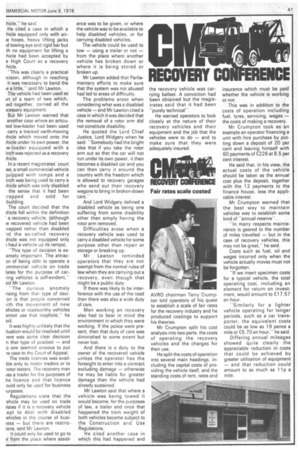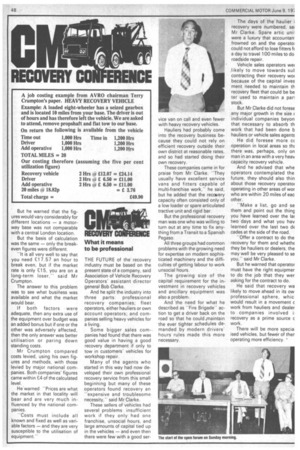Fair rates scale costed
Page 49

Page 50

If you've noticed an error in this article please click here to report it so we can fix it.
AVRO chairman Terry Crum pton told Operators of his quest to establish a scale of fair rates for the recovery industry and he produced costings to support his theories. .
Mr Crumpton split his cost analysis into two parts. the costs of operating the recovery vehicles and the charges for their use.
He split the costs of operation into several main headings, including the capital costs of providing the vehicle itself, and the standing costs of rent, rates and insurance which must be paid whether the vehicle is working or not.
This was in addition to the costs of operation including fuel, tyres, servicing, wages — the costs of making a recovery.
Mr Crumpton took as an example an operator financing a unit with hire purchase by putting down a deposit of 20 per cent and leaving himself with 60 payments of £226 at 8.5 per cent interest.
He said that, in his view, the actual costs of the vehicle should be taken as the annual cost plus the deposit, together with the 12 payments to the finance house, less the applicable interest.
Mr Campton warned that the best way to maintain vehicles was to establish some kind of "annual reserve".
"In many respects maintenance is geared to the number of miles travelled — but in the case of recovery vehicles, this may not be great," he said.
Costs such as fuel, oil and wages incurred only when the vehicle actually moves must not be forgotten.
"If we insert specimen costs for a typical vehicle, the total operating cost, including an element for return on investment, would amount to £17.57 an hour.
"Similarly for a lighter vehicle operating for longer periods, such as a car transporter, the equivalent costs could be as low as 19 pence a mile or £5.70 an hour," he said.
Differing annual mileages showed quite clearly the appreciable reduction in costs that could be achieved by greater utilisation of equipment — and that reduction could amount to as much as 11p a mile. But he warned that the figures would vary considerably for different locations — a motorway base was not comparable with a central London location.
But the basis of calculation was the same — only the breakeven figures were different.
"It is all very well to say that you need £17.57 an hour to break even, but if the market rate is only £15, you are on a long-term loser," said Mr Crumpton.
The answer to this problem was to see what business was available and what the market would bear.
If both factors were adequate, then any extra use of the equipment over budget was an added bonus but if one or the other was adversely affected, then the only answer was better utilisation or paring down standing costs.
Mr Crumpton compared costs levied, using his own figures and methods, with those levied by major national companies. Both companies' figures came within £4 of the calculated level.
He warned "Prices are what the market in that locality will bear and are very much influenced by the national companies.
"Costs must include all known and fixed as well as variable factors — and they are very susceptible to the utilisation of equipment.




















































































































































